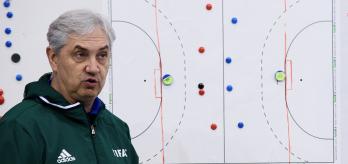Organisation
-
Use one half of the court.
-
Divide the court into three zones.
-
Mark out one end zone 2m from the goal line.
-
Mark out the other end zone 3m from the halfway line.
-
The middle zone should be approximately 18m in length and account for the majority of the playing area.
-
Position a goalkeeper and a pivot from each team in each end zone.
-
Create a 3v2 scenario in the middle zone.
-
One player from the team with a numerical disadvantage waits outside the playing area and only joins play when their team gain possession.
Explanation
-
The game should be end to end, and play should be fluid.
-
The in-possession team have a 3v2 numerical advantage at all times.
-
Each team aim to pass the ball from one end zone to the other.
-
Play starts with the goalkeeper, who can pass the ball to any team-mate in the middle zone. Each member of the in-possession team must touch the ball before play can be progressed into the end zone.
-
If the out-of-possession team win the ball back, they gain the numerical advantage and play continues from that point.
-
One member of the team that is now out of possession leaves the playing area.
-
There are no restrictions on the number of touches allowed.
Variations
-
Variation 1: if a team play the ball into the pivot, they retain possession and try to transition to the opposite end zone.
-
Variation 2: goalkeepers play in the middle zone to work on their passing and ball control skills.
Coaching points
-
Players must look after the ball, as a failure to do so can result in their team losing their numerical advantage and struggling to win the ball back.
-
Forward passes should be considered a priority, as they allow players to progress play more quickly through the zones.
-
Given their numerical advantage, it should be easier for the members of the in-possession team to create and open up passing lines off the ball.
-
Intelligent and constant movement can serve to disorganise the opposition, who find it hard to pick players up when facing a numerical disadvantage.

























